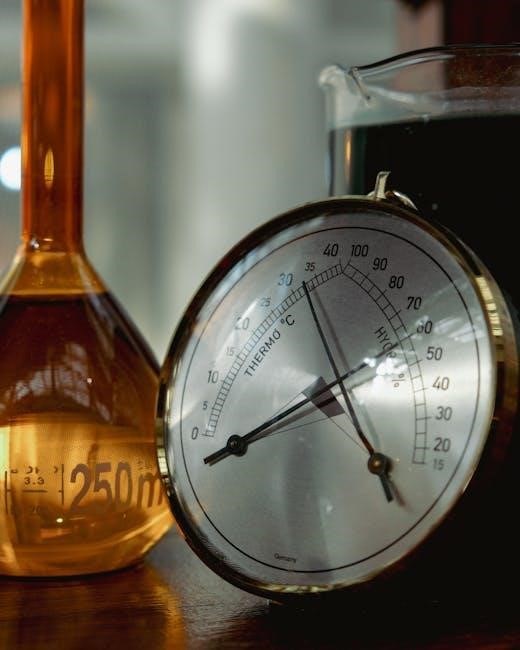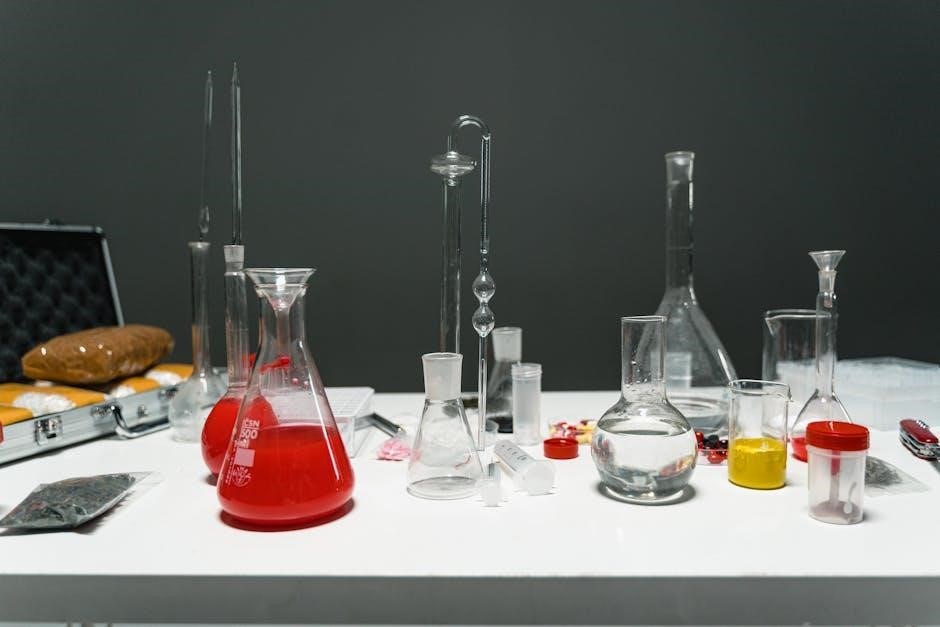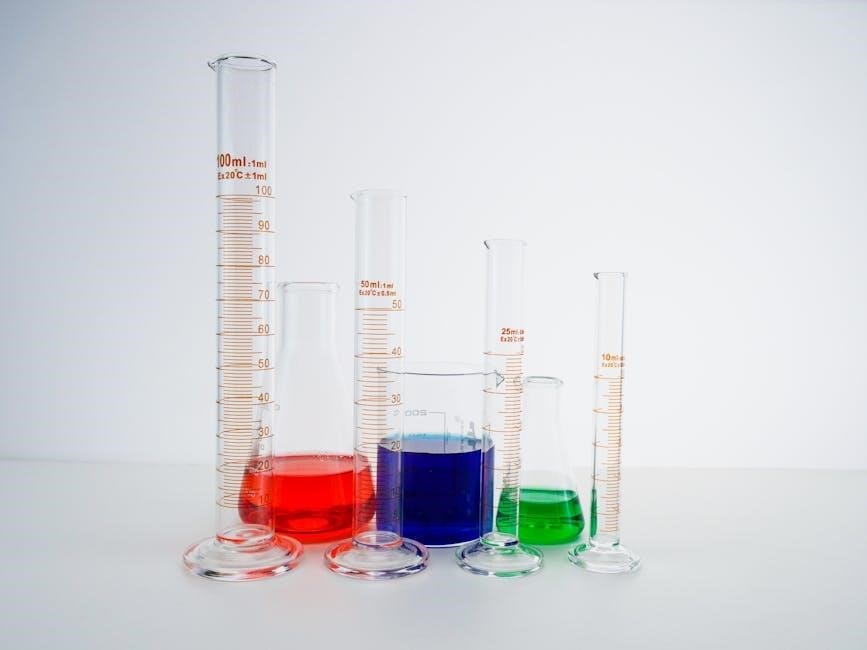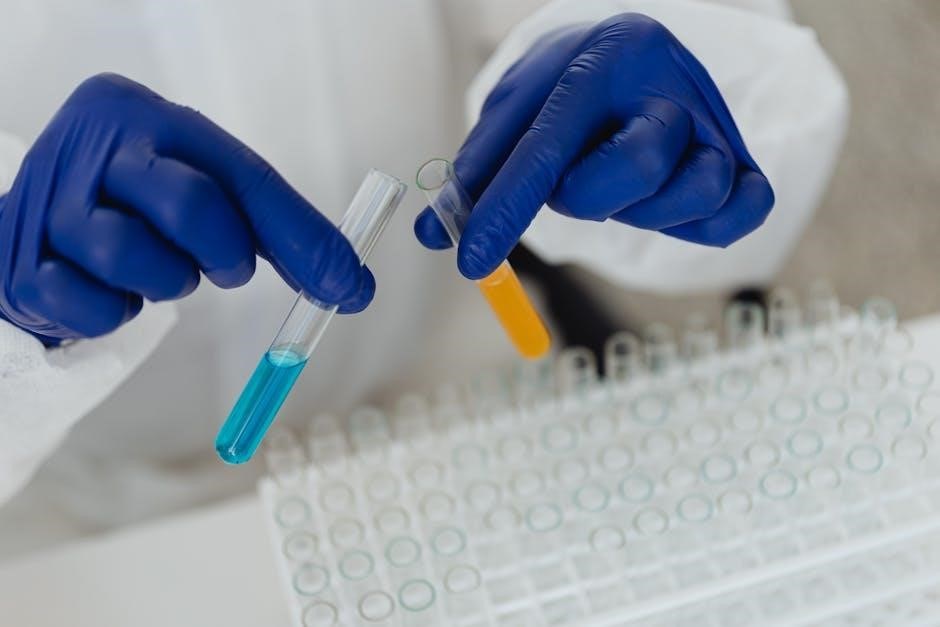Quantitative chemistry focuses on measuring chemical quantities and understanding reactions through numerical data. It involves precise calculations‚ stoichiometry‚ and error analysis‚ forming the backbone of chemical problem-solving. PDF resources and practice questions provide comprehensive study materials for mastering these concepts and techniques.
What is Quantitative Chemistry?
Quantitative chemistry is the branch of chemistry that deals with numerical measurements and calculations to understand chemical processes. It involves precise quantification of substances‚ reactions‚ and properties‚ using concepts like moles‚ concentrations‚ and stoichiometry. This field relies heavily on accurate data collection and mathematical analysis to predict and optimize chemical reactions. Resources like PDFs and practice questions provide detailed insights and exercises to master these fundamental principles and their practical applications in chemistry.
Why is Quantitative Chemistry Important?
Quantitative chemistry is essential for understanding chemical reactions‚ stoichiometry‚ and the precise measurement of substances. It provides a foundation for predicting reaction outcomes‚ optimizing processes‚ and ensuring accuracy in scientific and industrial applications. By mastering concepts like moles‚ concentrations‚ and significant figures‚ chemists can solve complex problems and develop new technologies. Resources such as PDF guides and practice questions help students and professionals refine their skills in this critical area of chemistry.

Chemical Measurements and Significant Figures
Chemical measurements involve precise data collection‚ while significant figures ensure accuracy in calculations. Both are vital for reliable results in quantitative chemistry‚ as highlighted in practice PDFs and quizzes.
Basics of Measurement in Chemistry
In chemistry‚ measurements are fundamental for quantifying substances and reactions. Key concepts include SI units‚ precision‚ and accuracy; Tools like balances and burettes enable precise data collection. Understanding significant figures ensures reliable results. Measurements form the basis of calculations‚ such as molarity and mass. Accurate data is critical for stoichiometry and chemical equations‚ emphasizing the importance of careful techniques. Practice questions in PDF resources help master these foundational skills‚ essential for advanced quantitative chemistry applications.
Significant Figures and Their Role in Quantitative Chemistry
Significant figures are crucial in quantitative chemistry as they represent the precision and accuracy of measurements. They include all certain digits and the first uncertain digit. Rules govern their application‚ such as non-zero digits always being significant and zeros being significant if between non-zero digits or trailing in a decimal. Significant figures ensure reliable calculations and conclusions‚ minimizing errors. Practice questions in PDF resources help students master these rules‚ enhancing their ability to interpret and report data accurately in chemical analyses and stoichiometric calculations.

Moles and Avogadro’s Number
Moles quantify matter at the microscopic level‚ linking amounts of substances to Avogadro’s Number (6.022 x 10²³ atoms/mole). This fundamental concept enables precise calculations in chemistry.
The Concept of the Mole
The mole is a fundamental unit in chemistry‚ defining the amount of substance. One mole contains approximately 6.022 × 10²³ particles‚ known as Avogadro’s number. This concept allows chemists to relate macroscopic measurements to microscopic particles‚ simplifying calculations in stoichiometry and chemical equations. Understanding the mole is crucial for quantifying reactants and products‚ making it a cornerstone of quantitative chemistry. PDF resources often include practice problems to master mole calculations‚ ensuring accuracy in chemical analyses and reactions.
Avogadro’s Number and Its Applications
Avogadro’s number (6.022 × 10²³) is a cornerstone of quantitative chemistry‚ linking macroscopic quantities to microscopic particles. It enables calculations of molar masses‚ concentrations‚ and gas volumes. This constant is vital in stoichiometry‚ allowing chemists to balance chemical equations and determine reactant ratios. PDF resources often include practice problems to master Avogadro’s applications‚ such as converting between moles‚ particles‚ and volumes. Understanding this concept is essential for solving quantitative problems in chemistry‚ from laboratory experiments to industrial applications.

Stoichiometry and Chemical Equations
Stoichiometry involves balancing chemical equations and calculating reactant-to-product ratios. It is fundamental for quantitative chemistry‚ enabling precise predictions of reaction outcomes and resource optimization.
Writing and Balancing Chemical Equations
Writing and balancing chemical equations is a fundamental skill in quantitative chemistry. It involves identifying reactants and products‚ balancing atoms‚ and ensuring charge neutrality. Practice questions often focus on stoichiometry and conservation of mass. Common mistakes include forgetting to balance diatomic molecules or miscounting atoms. Resources like past exam papers and PDF guides provide step-by-step solutions‚ helping students master equation balancing and apply it to real-world problems effectively.
Stoichiometric Calculations
Stoichiometric calculations involve using balanced chemical equations to determine quantities of reactants and products. These calculations are essential for solving problems like mole-to-mass conversions and empirical formula determinations. Practice questions often focus on limiting reagents‚ percent yield‚ and gas volume relationships. Resources such as PDF guides and online platforms provide detailed step-by-step solutions‚ helping students master these calculations and their practical applications in chemical synthesis and analysis.

Concentration of Solutions
Concentration of solutions is defined by the amount of solute per unit volume or mass of solvent. Key concepts include molarity‚ molality‚ and normality. Preparation methods involve dilution or dissolving solutes‚ while calculations use formulas like M1V1 = M2V2. These principles are vital for titrations and solution analysis. PDF guides and practice questions provide detailed examples and problems to master these calculations and techniques.
Defining Concentration
Concentration quantifies the amount of solute in a solution. Common terms include molarity (moles of solute per liter of solution) and molality (moles per kilogram of solvent). Normality refers to equivalents of solute. Understanding these definitions is crucial for accurate solution preparation and analysis. Practice questions in PDF guides often involve calculating concentrations using these formulas‚ ensuring mastery of concepts like dilution and solute distribution. These calculations are essential for titrations and chemical synthesis.
Preparation and Calculation of Solution Concentration
Preparing solutions involves measuring solute mass‚ dissolving it in a solvent‚ and diluting to a known volume. Concentration is calculated using formulas like molarity (moles of solute per liter of solution). Dilution problems use M1V1 = M2V2. Practice questions often test these calculations‚ ensuring accuracy in solution preparation. Understanding these principles is vital for titrations and chemical synthesis‚ where precise concentrations are critical for reactions and analysis.
Acid-Base Chemistry and Titration
Acid-base chemistry involves titrations to determine concentrations of acids and bases. These reactions are fundamental in quantitative analysis‚ especially in finding equivalence points in strong or weak acid-base solutions.
Acids and bases are fundamental in chemistry‚ defined by their ability to donate or accept protons. The Arrhenius theory describes acids as proton donors and bases as hydroxide ion producers. Bronsted-Lowry expanded this concept‚ emphasizing proton transfer‚ while Lewis theory focuses on electron pair sharing. These definitions are crucial for understanding reactions‚ pH calculations‚ and titration processes. Quantitative chemistry questions often involve calculating acid/base concentrations and neutralization reactions‚ essential skills for chemists. PDF resources provide detailed explanations and practice problems to master these concepts.
Titrations and Their Quantitative Aspects
Titrations are laboratory techniques used to determine the concentration of a solution by reacting it with a solution of known concentration. They involve precise measurements and calculations to find the equivalence point. Quantitative aspects include calculating molarity‚ volume‚ and concentration ratios. Acid-base and redox titrations are common types‚ requiring accurate data to ensure reliable results. Practice questions and PDF resources often focus on these calculations‚ helping students master titration principles and their practical applications in chemistry.

Errors and Uncertainty in Chemical Measurements
Errors and uncertainty are inherent in chemical measurements‚ affecting accuracy and precision. Systematic and random errors must be identified and minimized. Quantitative chemistry relies on understanding and reporting uncertainty to ensure reliable results‚ using techniques like significant figures and standard deviations to express precision.
Types of Errors in Quantitative Chemistry
In quantitative chemistry‚ errors are classified into systematic and random types. Systematic errors arise from flawed methods or instruments‚ while random errors occur due to unpredictable variations. Both types affect measurement accuracy and precision. Identifying and minimizing these errors is crucial for reliable results. PDF resources and practice materials often include questions addressing error types‚ helping students understand their impact and how to mitigate them in chemical analyses.
Minimizing and Reporting Uncertainty
In quantitative chemistry‚ minimizing uncertainty involves precise measurements‚ calibration‚ and repetitive sampling. Proper reporting includes stating results with appropriate significant figures and expressing uncertainty clearly. PDF guides often provide examples and exercises to help students master these techniques‚ ensuring accurate and reliable data presentation in chemical analyses.

Conservation of Mass and Chemical Reactions
Conservation of mass states that matter cannot be created or destroyed in a chemical reaction. It is a fundamental principle used to balance equations and calculate amounts of reactants and products. This concept is supported by practice questions in PDF resources‚ helping students apply it in various chemical scenarios.
Law of Conservation of Mass
The Law of Conservation of Mass states that matter cannot be created or destroyed in a chemical reaction. This principle is crucial in quantitative chemistry for balancing equations and calculating masses of reactants and products. By applying this law‚ chemists ensure mass consistency in reactions‚ enabling accurate stoichiometric calculations. PDF resources and practice questions provide comprehensive support for understanding and applying this fundamental concept effectively. Additionally‚ these resources include multiple-choice and short-answer questions‚ allowing students to test their understanding and problem-solving skills.
Applying Conservation of Mass in Chemical Calculations
Conservation of mass ensures accurate calculations in chemical reactions by maintaining mass balance between reactants and products. This principle is applied to determine unknown masses‚ verify reaction completeness‚ and validate experimental data. PDF resources and practice questions provide step-by-step solutions‚ enabling students to master calculations involving stoichiometry and mass relationships. These materials include worked examples‚ multiple-choice questions‚ and short-answer exercises‚ fostering proficiency in applying conservation of mass to real-world chemical problems and laboratory scenarios.

Periodic Table and Atomic Structure
The periodic table is a cornerstone of chemistry‚ organizing elements by atomic structure. Atomic mass is crucial for quantitative calculations‚ and PDFs offer detailed study guides.
Understanding the Periodic Table
The periodic table organizes elements by atomic number‚ revealing repeating patterns in chemical properties. It is divided into periods (horizontal rows) and groups (vertical columns)‚ with metals‚ nonmetals‚ and metalloids distributed across it. Atomic mass‚ a key concept in quantitative chemistry‚ is listed for each element. This table aids in predicting chemical behavior and calculating molar masses‚ essential for stoichiometric computations. PDF resources often include practice questions to test understanding of periodic trends and atomic properties.
Atomic Mass and Its Significance
Atomic mass‚ listed on the periodic table‚ represents the average mass of an element’s naturally occurring isotopes. It is crucial for calculating molar masses‚ which are essential in stoichiometry and quantitative chemistry. Understanding atomic mass helps in balancing chemical equations and determining the masses of reactants and products. Practice questions often involve calculating molar masses and using atomic mass to solve problems in chemical reactions and solution concentrations‚ making it a foundational concept in quantitative chemistry.
Resources for Quantitative Chemistry
Recommended PDFs and study materials provide detailed explanations and practice questions for mastering quantitative chemistry. Online platforms offer quizzes‚ past papers‚ and step-by-step solutions for exam preparation and concept understanding.
Recommended PDFs and Study Materials
Various PDF resources are available for mastering quantitative chemistry‚ including “Quantitative Chemistry Questions and Answers PDF” and “Chemical Calculations Workbook”. These materials provide solved problems‚ practice exercises‚ and detailed explanations‚ covering topics like stoichiometry‚ significant figures‚ and titration calculations. Additionally‚ “Quantitative Chemical Analysis” textbooks offer comprehensive guides with step-by-step solutions‚ ideal for students preparing for exams or seeking to deepen their understanding of chemical measurements and data analysis.
Online Platforms for Practice Questions
Several online platforms offer practice questions and resources for quantitative chemistry‚ such as Quizlet‚ Khan Academy‚ and Chem Libre. These platforms provide interactive quizzes‚ past exam questions‚ and step-by-step solutions. Websites like KnowIT and Bitesize also feature multiple-choice and short-answer questions tailored for GCSE and AQA syllabi. Additionally‚ forums and educational hubs offer access to PDF worksheets and practice tests‚ enabling students to self-assess and improve their understanding of stoichiometry‚ titrations‚ and chemical calculations.
Exam Preparation and Strategies
Effective exam preparation involves timed practice questions‚ reviewing past papers‚ and mastering quantitative chemistry questions. Utilize video lessons and quizzes for a structured approach to success.
Common Exam Questions in Quantitative Chemistry
Common exam questions in quantitative chemistry often focus on stoichiometric calculations‚ molar concentrations‚ and the conservation of mass. Students are typically asked to balance chemical equations‚ calculate moles‚ and determine solution concentrations. Titration problems and error analysis are also frequent. Practice questions from PDF resources and past papers cover these topics extensively‚ helping students master numerical problem-solving and data interpretation. Regular review of these questions ensures proficiency in handling both theoretical and practical aspects of quantitative chemistry.
Effective Study Techniques for Success
Mastering quantitative chemistry requires active learning and consistent practice. Engage with practice questions and past exams to build problem-solving skills. Use video lessons and online resources to supplement textbook learning. Regularly review notes and concepts‚ focusing on areas where mistakes occur. Apply concepts to real-world problems to enhance understanding. Utilize study materials like PDFs for revision and self-assessment. Dedicate time to solving numerical problems‚ ensuring accuracy and speed. Regular review and self-assessment are key to long-term retention and exam success.